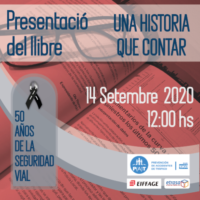
Imagen de Pete Linforth en @Pixabay
What price do you put on life?
The "NO" at 8 hours of theory classes - The theory to drive will be cheaper...
It will not be compulsory to attend face-to-face classes before the theoretical exam to obtain a driving license. The General Director of Traffic Mr. Pere Navarro, in his appearance at the Road Safety Commission of Congress, explained that all references to the obligation to attend these 8 hours of face-to-face theoretical class have been withdrawn from the draft Royal Decree that the DGT is preparing to modify the Regulation of Drivers.
In its day, the measure caused complaints from digital driving schools and which have now been the only way of studying for applicants for the license during the coronavirus pandemic. In addition, at the end of last year, the National Commission of Markets and Competition (CNMC) published an unfavorable report with said measure.
Training in Driving Schools is one of the most important keys to close the door to road accidents from the beginning. Dehumanizing this value in favor of a mercantile point of view that confronts economic interests between two teaching models, one face-to-face and the other online, is dangerous if a deeper analysis is not addressed.
Education has been adding new technologies also in Driving Schools and the mandatory 8 hours of face-to-face classes was a commitment to a semi-face-to-face or “blended” training model. The intention was not to lose the social contact that exists in driving school classrooms between teachers and students, understanding that there are values such as sensitization and awareness that in person it is still difficult to anchor, with durability over time, in future drivers. . Now, we fear that non-face-to-face only online training will lead to an increase in road accidents.
Safe mobility must be a reality in any civic society and that is why road safety education must exist in our learning trajectory as individuals throughout our lives. Driving schools play a very important role as they are in a place along this trajectory where they are going to train us to learn how to drive motorized vehicles, machines that transport lives inside, that will circulate in adverse weather conditions, high speeds,… and that They will also generate risks for third parties when circulating very close to pedestrians in urban environments, athletes on roads, other vehicles with which they will share roads, etc.
A reckless driver who enjoys speed, an irresponsible driver who takes drugs and/or drinks before driving, a driver who drives as relaxed as if he were on the sofa at home or another inattentive because of the telephone conversation he is attending while driving , are some of the examples of uncivic behavior, bad habits, unconsciousness and many other things, which must be able to be effectively combated before a person sits behind the wheel of a car for the first time or takes the handlebars of a motorcycle.
In this consumer and fast-paced society in which we are immersed, we do not usually have time to think about certain things that surround us and that in some cases can even save our lives… or skew them.
Faced with this situation or debate on betting on face-to-face, semi-face-to-face or online training, we should start by asking ourselves what value we give to the training and exams that future drivers have to pass and why we believe these exams exist.
Unfortunately, the popularized idea is that you go to the driving school “to pass” the exams and get your permit and not to learn to drive. Arriving at that conclusion that you only go to pass, the next obvious step was to try to go as little time as possible and spend as little money as possible. But it is a serious mistake not to give value to the time needed to acquire good road training provided by Driving Schools and not consider that this time and the economic cost are an investment for the present and future to be a good driver.
The theoretical training of the Driving Schools is seriously despised by too many students and the conclusion is very generalized that it is faster to inflate yourself to do tests like the ones that will come out in the exam than to listen to a class or open the book. A student who seeks to obtain the permit by investing the minimum time possible, preferring to take a test, is a student who does not know the value and need to learn the entire Highway Code and the civic values of mobility and road safety, which are so necessary to avoid accidents. What kind of driver will that person be?
We could ask ourselves how we have reached this point with the theoretical exams and with that contempt for training. Perhaps we stumbled upon this situation a long time ago, when it became known that there were students who knew the content but failed questions because they did not understand or interpret the questions or answers well, and the quick solution was to provide tests to test this technique, form and exam language. Possibly it could have been a better option to have proposed a solution that would have imperatively ensured that all the questions and answers avoided intentional or erroneous confusion to understand and understand them.
This would have improved suspending or approving a student for their knowledge of the subject and not for their ability to understand, comprehend, unravel, etc. the writing of some questions and answers of the test exam.
Needing or deciding to take a test makes it easier to pass with less knowledge and values acquired, disregarding training and that does not create good drivers. We must stop memorizing tests and recover learning by taking advantage of new technologies to improve training, without underestimating the face-to-face form taught by a driving school teacher, which continues to be the best formula par excellence, since our need to socialize with other human beings makes that formative experience deeper.
For the practical exam, the fair practices are also done to pass and not to learn to drive. The greatest justification of the students is the economic cost, but they should stop and assess the economic cost of being a bad driver for having saved on training when this can cause the loss of some life including their own and everything that this would entail for the victims themselves and their close circles of family, friends, work environment, etc.
In any case, the system is also dangerously benevolent and reckless, facilitating that less practice is required and consequently, no student who passes has experienced, in a supervised and safe environment, emergency braking, aquaplaning, under/oversteering and many other reactions. physical characteristics of the vehicles, so it is most likely that some of these insufficiently prepared drivers, in the event of an unforeseen event, make a counter-steering that they will not know how to control, brake intensely instead of gradually decreasing, losing grip, do not appreciate excessive speeds and stop late , they do not know that their bodies will not withstand certain sudden decelerations, they have not felt the weight transfers in curves, accelerations and braking and how they affect the limits of tire adherence… and many other dynamic reactions of the vehicles and their electronic assistance .
The face-to-face learning of the Driving Schools has shortcomings and the online increases them. The system gives students theoretical and practical notions to pass the exams… but it does not really prepare them to drive with the safety, skill, civility, responsibility and preventive awareness necessary to avoid road accidents, both in the immediate present when it is given to them the permit, as in their future when they self-develop as drivers. Consequently, if there have not been good training foundations in knowledge, values and awareness, we cannot expect drivers who are “skillful” in normal driving and in unexpected situations, “responsible” in compliance with the Traffic Code, “civic” in the use of the vehicle and with the pedestrian population and other road users, and “safe” not causing risks or accidents to third parties or themselves.
It would also be necessary to talk about a necessary recycling over the years that the permit has been obtained.
How many drivers refresh and update their knowledge on regulations and new driving technologies? And refresh civility, prevention, consequences behind the wheel, sensitization, awareness,…?
To finish, it should be mentioned how to improve the medical check-ups necessary to have the permit or renew it. It would be interesting to emphasize the psychological section on the individual to better detect and prevent possible dangerous behaviors behind the wheel. In the same way, it is necessary to avoid the traps that drivers make to pass the inspection or the economic conflict of these centers that carry out the inspections, which encourages some professionals to do “the view
fat woman”.
In short, if we want better drivers on the roads and fewer accidents, we need…
– Education and awareness from childhood on safe, civic and sustainable mobility.
– Quality theoretical and practical training and valued in Driving Schools to learn to drive and behave behind the wheel and not just to pass.
– An optimized exam system that does not encourage pass tactics that harm training and learning.
– Retraining throughout life as a driver to refresh and update knowledge, and reinforce awareness and sensitivity behind the wheel.
– Better medical check-ups with more psychological emphasis to prevent dangerous behaviors. With access to our complete medical history to avoid concealment. And with a review service that avoids the conditioning economic conflict of the current privatized system of revisions.
José Miguel Escrig Agut, P(A)T Castellón delegate











